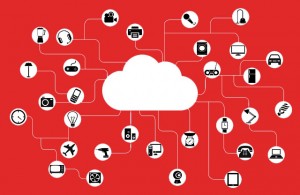“The internet of things” — a rather unimaginative way to describe something vast. What did Kevin Ashton mean when he used the phrase for the first time in 1995?
What is it?
The Internet of Things (IoT) refers to connected devices communicating with each another and using machine-to-machine (M2M) communication via virtual, mobile or instantaneous connections.
This network of physical objects is embedded with electronics, software, sensors, and network connectivity, enabling the objects to collect and exchange data.
They can include any object fitted with the right technology and the ability to connect to the internet. For example, home appliances, most forms of transport, shops and machines used for manufacturing, farming, healthcare, etc. Existing M2M applications include smart metering, patient monitoring, CCTV surveillance, vehicle tracking, secure ATMs and digital signage.
 What can it be used for?
What can it be used for?
The main advantages of The Internet of Things is increased productivity, efficiency and better organisation of tools, machines and people.
One area where IoT can be most beneficial, is healthcare. Diseases can be monitored and analysed to create new treatments and also prevented in the long run.
In farming, sensors are connected to crops and cattle to increase production and track herds.
In the home environment security systems and household appliances can be monitored and controlled. In future your fridge will be able to let you know when you are out of milk and possibly even order it online for you. You will be able to activate your coffee machine from your cell phone to have a cup of hot coffee waiting when you get home.
LG recently introduced
LG Homechat which enables you to SMS any of your LG home appliances. And yes, they answer back. Unfortunately this functionality isn’t available in South Africa yet, but it’s out there and being used.
These are simple examples, but the possibilities are vast. For more ideas, have at this interactive
web application.
Is it safe?
IoT has many advantages, but the biggest concern, especially in its early stages, is security and privacy. To function optimally these devices need your personal data and since everything will be connected, in the cloud or on companies’ databases, it will also be available for if proper security is not in place.
Healthcare is most at risk if data is tampered with or leaked. Deleting sensitive medical information, such blood group info, could have fatal repercussions. (
More in the Guardian)
According to experts IoT is relatively safe, but there’s no guarantee.
“The internet of things” — `n taamlike flou manier om iets vreeslik omvangryk te beskryf. Wat was Kevin Ashton bedoel daarmee toe hy dit vir die eerste keer in 1995 gebruik het?
Wat is dit?
Die Internet of Things (IoT) verwys na enige toestelle wat verbind is aan mekaar en met masjien-tot-masjien (M2M) kommunikasie werk, met behulp van van virtuele, mobiele en onmiddellike verbindings.
Hierdie netwerk van fisiese toestelle is toegerus met elektronika, sagteware, sensors en netwerkverbindings wat hulle in staat stel om data uit te ruil en te versamel.
Toestelle kan enigiets insluit wat toegerus is met die regte tegnologie en aan die internet kan verbind. Byvoorbeeld, huishoudelike toestelle, vervoermiddele, toestelle in winkels, vervaardigingsmasjienerie, landbou-masjinerie, sowel as toestelle gebruik in gesondheidsorg. Bestaande M2M toepassings sluit slim meterlesings, monitering van pasiënte, CCTV-toesig, voertuig-opsporing, sekure ATMs en digitale kennisgewingborde in.
 Wat is die nut daarvan?
Wat is die nut daarvan?
Die grootste voordele van The Internet of Things is verhoogde produktiwiteit, effektiwiteit en organisasie van hulpbronne, masjinerie en mense.
In gesondheidsorg kan siektes kan monitor en analiseer word om nuwe behandelings te ontwikkel en op die lang duur, siektes te kan voorkom.
In vervaardigingsomgewings, soos landbou, word sensors aan gewasse en vee vasgemaak om produksie te verhoog en troppe na te speur.
Tuis kan sekuriteitstelsels en huishoudelike toestelle monitor en beheer word. In die toekoms sal jou yskas jou laat weet as die melk op is en dit moontlik vir jou aanlyn bestel. Jy sal jou koffiemasjien kan aktiveer met jou selfoon sodat daar ʼn koppie vars koffie wag as jy by die voordeur instap.
LG het onlangs
LG Homechat, ʼn toepassing wat jou in staat stel om enige van jou LG huishoudelike toestelle te SMS, bekendgestel. En ja, hulle antwoord terug. Ongelukkig is dié nuutjie nog nie in Suid-Afrika beskikbaar nie, maar dit word reeds oorsee gebruik.
Hierdie is net die ysberg se punt. Die impak van IoT strek veel wyer. Om ʼn idee te kry van wat alles moontlik is, kyk gerus na hierdie informatiewe
webtoepassing.
Is dit veilig?
Die grootste bekommernis, veral in die vroeë stadium van ontwikkeling, is sekuriteit sekuriteit en privaatheid. Om optimaal te kan funksioneer, het hierdie toestelle jou persoonlike data nodig. Dit moet ook verbind wees aan ander toestelle d.m.v. die cloud of maatskappye se databasisse. Indien streng sekuriteit nie in plek is nie, sal persoonlike inligting toeganklik kan wees vir enigiemand wat dit wil misbruik.
Gesondheidsorg bied die hoogste risiko indien daar met data gepeuter of dit uitgelek word. Sensitiewe inligting wat uitgevee word, byvoorbeeld bloedgroep inligting, kan noodlottige resultate hê. (
Meer hieroor in die Guardian)
Deskundiges beweer dat dit relatief veilig is, maar daar is geen waarborg nie.
Tags: internet of things
This entry was posted
on Friday, November 20th, 2015 at 8:00 am and is filed under General, Internet.
You can follow any responses to this entry through the RSS 2.0 feed.
Both comments and pings are currently closed.
 What can it be used for?
What can it be used for? Wat is die nut daarvan?
Wat is die nut daarvan?
